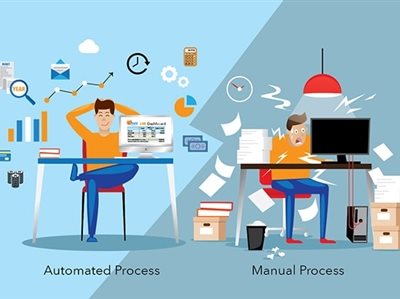
What is reconciliation?
Reconciliation in process of comparing and confirming between two set of similar independent data to check if data are correct and are in agreement with each other, complete and accurate. It is vastly used in business across operational, financial and compliance Processes. Value it generates is trust or reliability of Data. It finds it significant usage in Accounting perspective, wherein through this process finance executive confirm whether the account balances between two accounts at the end of an accounting period are valid, complete and accurate. In case any discrepancy is noted they are reviewed and corrected. According to various estimates typically 20-30% of organization operation, finance and compliance team spend time on reconciliation and reporting related activities. Thus, indicating huge opportunity for automation for bringing efficiency and improving quality of reconciliation.
Why do we need automation in reconciliation?
- Typically, whole business right from right from CFO/CEO/COO/CIO to people at executive level spend substantial time in getting figure reconciled, solving reconciling difference, taking corrective action and monitoring of same. Many estimates suggest 5-6 day/month time of effective business human hours are spend on same. None of these hours add to true business value creation except for giving comfort or trust in data.
- Further larger time is spent in correcting the error which arises due to manual input error and delay in entries. This again requires considerable time reworking the accounts and reissuing them if inaccuracies in financial data were not identified prior to reporting.
- In fact we have seen many of them remain always un-reconciled and not corrected and ultimately result in financial, regulatory or reputation loss.
The cost-effective solution to all this is to automate them

Automation –The Solution
Making this system more technology based or automating the system would bring more ease and accuracy to the business operation including delivering accurate financial information. Moreover, it would enable process and system to be more streamlined bringing better quality of data for business decisioning, financial reporting, closing and compliance reporting.
Automation of input coupled with automation of reconciliation improves consistency and validation process. It enables efficiency brought through enhanced processing speed and capacity. Further reporting timing can be improved as validation, adjustment and calculation steps of multiple processes can be performed in parallel by the automated program.
In fact enhanced business control management can be achieved through standardizing and consistently applying thresholds, levels of materiality and business rules. This can help to prevent and address data and control inconsistencies in timely manner.
Automation also enable online working, reduced physical space requirements, thus enabling virtual reconciliation.

Automation for reconcilation can be used in:
Operation-
Few areas where it is often used are: Sales lead in sales system vs sales lead captured in ERP, customer relationship management reconciliation, Production plan vs plan in ERP system, Inventory recorded vs Gate records, customer service satisfaction calls tracker in portals vs calling system, Incident or service request in tool vs record in the system. Travel ticket booked in vendor tracker vs travel in system, Attendance in bio metric devices vs Leave records system . Third party SLA reported by vendor vs in tools, Changes migrated in tool vs changes recorded in application etc.
Finance and compliance – Following are few illustrative areas : Accruals, Cash and Bank reconciliation, GR/IR, Cash Application, Credit Card (Merchant to POS to GL), Benefits(Payroll/ Incentives/Insurance Provider Billing), Travel and expenses, Account payable , Account receivable , Inventory, Sold Shipped Not Paid ,Gifts & Grants, Purchasing Gift/Reward Cards,Tax Withholding & Remittance, Inter company Internal Cash, Non-Financial, Payroll, Point of sale with collection, point of sale with ERP revenue, Subledger(AR/AP/FA/Other), Treasury Management, GST Reconciliation, Unclaimed Property and Warranty Claims etc.
Tools used for automated reconciliation
Blackline- BlackLine is a cloud financial close solution that helps drive continuous improvement across finance and accounting organization. The software provides automated account reconciliation process that helps produce quality and fast reconciliation with automated, rules-based workflows with embedded controls, this enable to Streamline the financial close by simplifying the reconciliation process .
Xero- Xero is an online accounting solution for small businesses . It enables accounting, easy cashflow preparation in real-time basis. it enables to set up rules for matching bank transactions automatically to invoices, bill payments and purchases that are already recorded in Xero, making reconciliation seamless. with online billing, banking and accounting.
Recon- The Recon reconciliation system helps to automate most of the financial reconciliation and account balancing processes in a single system. it has data translation, and rules-based matching and investigative tools, This enable better visibility into cash, holdings, transactions, trial balances and security masters. Its enables to t automates the entire process from data collection and aggregation through matching and exception reporting, enabling true exception-based management
Traverse- Traverse is an ERP system from Open Systems, Inc. (OSAS) offering enterprise accounting financial, operations, and sales functionality. Traverse provides comprehensive integration for key business processes, while offering the ability to scale from 5 to 500 users. It enable rule based automated Bank reconciliation, it also has Interactive dashboards to help business leaders translate data into the insights require to make profitable company decisions.
Beside above cloud based solutions, they are many more cloud solutions like Oracle, workiva, onestream etc. In fact many time simple Visual basic and excel automation provide excellent cost effective results. Beside above company may go for ERP customization, Leverage robotic process automation tool from vendors like UI path, Automation anywhere ,Blueprism etc to automated build reconciliation. In fact they are several solutions which are currently available to enable automated and simplistic reconciliation.
However to derive best result, organization should set up governance mechanism, build steering committee team, identify complete inventory of operational, financial and regulatory reconciliation areas and thereafter only select best fit tool for same. It may then start implementation by identifying common pervasive process components such as data extraction, data validation and standard calculation and adjustment that cut across processes. This will enable them to cost effectively and smartly automate and build effective automated reconciliation solutions. Further organization should also have robust processes to drive corrective action plan including analytic to closely monitor closure of reconciliation difference and ensure end result of reconciliation is met. In nutshell for an effective automated reconciliation, organization should have governance, process, tools, corrective action and monitoring plan.
Co-authored by Nandika Arora


